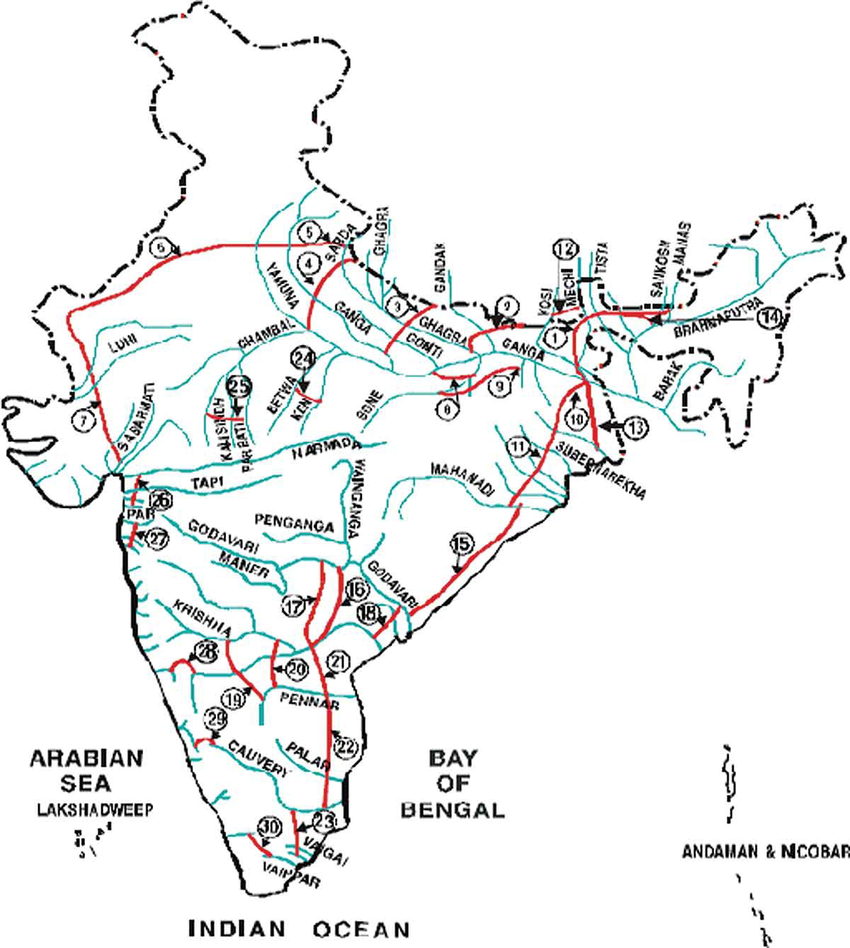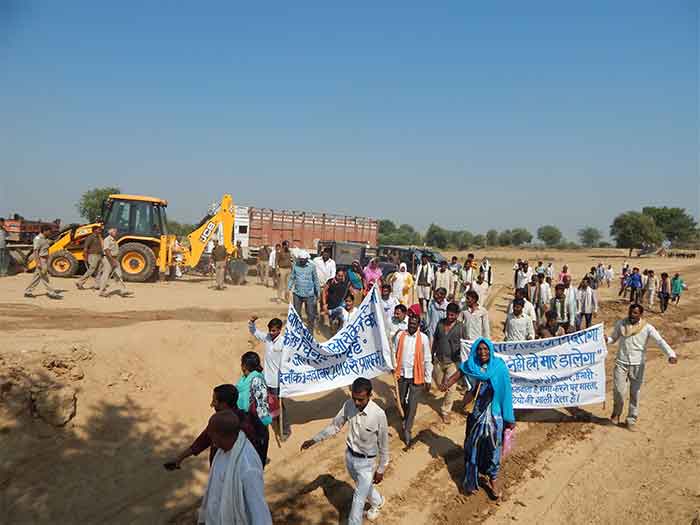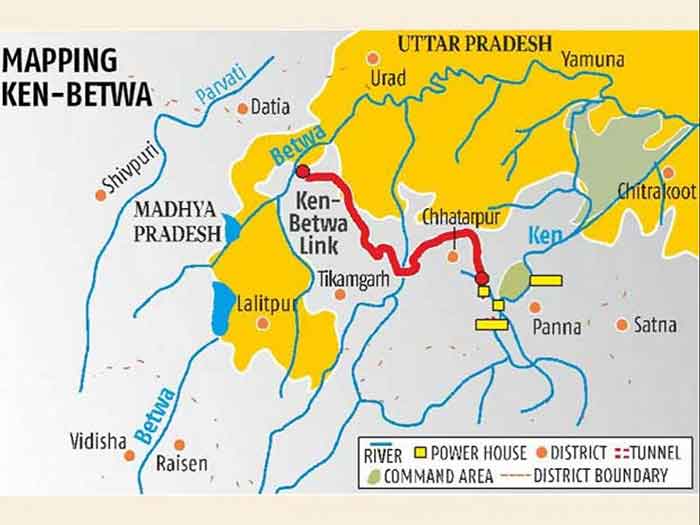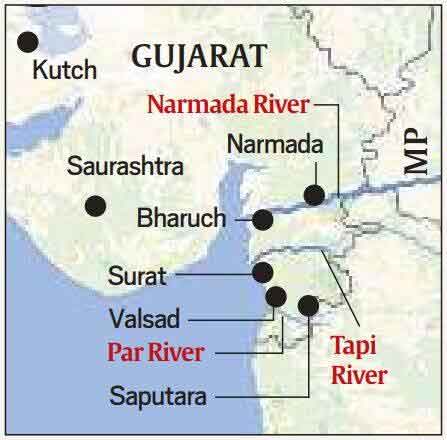
The Inter-Linking of Rivers (ILR) Project in India is one of the most gigantic water-transfer projects ever envisaged in the entire world. This involves 30 (or 29) links of 37 rivers all over the country. Its cost was officially projected at Rs. 11 lakh crore (one crore=10 million) in 2016, although this is now considered an underestimate.
This project was more or less given up in the UPA years due to its many sided criticism and its increasingly visible adverse impacts. However this was revived soon after the NDA government came to power in 2014. In an interview in 2016 Uma Bharti, the then Water Resources Minister spoke about creating 31 new rivers and completing the entire project within a span of two decades. More recent official pronouncements speak about the gigantic project in equally enthusiastic terms although there is more concern now about getting all the concerned state governments to agree.
To get a measure of the big issues involved, let’s take a quick look at the 30 projects. Actually it is a range of 29-32 depending on whether components of two projects are counted separately or not. There are about 16 projects involving peninsular rivers and about 14 involving Himalayan ones. The feasibility report of most of these projects has been completed and in the case of a few projects the Detailed Project Report has also been completed. In the case of others the pre-feasibility report has been prepared.
Coming to peninsular rivers, the first project involves linking of Mahanadi ( Manibhadra) and Godavari ( Dowlaiswaram) link. This involves 8 states—Jharkhand, Madhya Pradesh, Chattisgarh, Telengana, Andhra Pradesh, Katnataka, Odisha and Maharashtra. The second component of this project which involves linking of Mahanadi ( Bermul) and Godavari (Dowlaiswaram) also involves these same 8 states.
The second project envisages the linking of Godavari ( Inchampalli) and Krishna (Pulichintala) rivers. This involves seven states Odisha, Madhya Pradesh, Chattisgarh, Telengana, Andhra Pradesh, Maharashtra and Karnataka. The third project involves the linking of Godvari ( Inchampalli) and Krishna ( Nagarjunsagar), involving the same 7 states. Then there is the link of Godavari ( Polavaram) and Krishna ( Vijaywada) involving the same states. Next there is the link of Krishna ( Almatti) with Pennar, involving four states Telengana, Andhra Pradesh, Maharashtra and Karnataka, as also link of Krishna( Srisailam) with Pennar and link of Krishna ( Nagarjunsaar) with Pennar, involving the same states.
Next there is the link of the Pennar ( Somasila) with the Cauvery ( Grand Anicut) involving Andhra Pradesh, Karnataka, Tamil Nadu, Kerala and Puducherry. There is also a link of three rivers—Cauvery ( Kattalai), Vargai and Gunder rivers, involving 4 states—Kanataka, Tamil Nadu, Kerala and Puducherry.
The tenth project in the category of peninsular rivers is the widely discussed Ken-Betwa link, involving Uttar Pradesh and Madhya Pradesh. Then there is a link of 3 rivers Parbati, Kalisindhu and Chambal, affecting Madhya Pradesh, Uttar Pradesh and Rajasthan. The second component of this project also involves 3 rivers—Parbati, Kuno and Sindh, involving Madhya Pradesh and Rajasthan.
The Par-Tapi-Narmada Project involves Gujarat and Maharashtra. The Damanganga-Pinjal project also involves these two states. The Bedti-Varada link involves Maharashtra, Andhra Pradesh and Karnataka. The Netravati-Hemvati link involves Karnataka, Tamil Nadu and Kerala. The Pamba-Achkankovil-Vaippar link involves Kerala and Tamil Nadu.
Coming now to links of Himalayan rivers, the first project is M-S-T-G link or the link of 4 rivers Manas, Sankosh, Tista and Ganga, involving Bhutan and 3 states of India—Assam, W.Bengal and Bihar. Secondly, there is the Kosi-Ghaghra link involving Nepal with two states of India Bihar and UP. The involvement of Nepal with these two states is also there in the Gandak-Ganga link and the Ghaghra Yamuna link while the Yamuna-Sarda link involves Bihar, UP, Uttarakhand, Rajasthan and Haryana. Next there is the Rajasthan-Sabarmati link. Then there is the Chunar-Sone Barrage Link ( or Ganga-Sone Link) involving UP and Bihar, followed by Sone Dam link (Southern tributaries of Ganga link, Sone and Badua), involving Bihar and Jharkhand.
The next link is the Ganga ( Farakka)-Damodar-Subarnarekha link, involving W.Bengal, Odisha and Jharkhand. There is also a planned link of Subarnarekha and Mahanadi involving W.Bengal and Odisha. The Kosi-Mechi link involves Nepal and 2 states of India Bihar and W.Bengal. Finally there is the Ganga-Farakka Sunderbans link or Ganga-Ichamati link in W.Bengal.
So far the two projects which have been the most widely discussed include the Par-Tapi-Narmada link and the Ken-Betwa link. The first was so widely opposed, particularly by tribal communities threatened with displacement and other adverse impacts, that its implementation had to be suspended in this election year in Gujarat. The Ken-Betwa link project has already become one of the most highly criticized projects of this kind, for reasons ranging from it basic non-viability due to lack of surplus water in Ken river and the the loss of over 2.3 million trees.
Taken as a whole, displacement and ecological costs are likely to be very high for this gigantic project. Displacement has to be seen in the context of not just dams but also a vast distance of canals. Water transfer over vast areas can also involve negotiating heights calling for very heavy energy costs of lifting water.
As in the case of several rivers not one but several links are being planned, the overall impact on river system has to be seen which cannot be captured in any single project report. As for the adverse impacts on the entire river system of the entire gigantic project in its totality, this is not being considered by the government at all despite its great importance.
Given the many imponderables, there are possibilities of the entire river system getting badly messed up by years of this work like never before with even escape routes blocked. Therefore, before the limited resources for development of water resources are pledged to an enormous extent in this extremely costly project, it is time to a wider consultation with all states, all stakeholders and independent experts, keeping the mind entirely open to the possibility of dropping this entire project.
The entire concept of forcing most of our rivers to find new paths and meeting points is a flawed one, and our limited funds would find a much better and safer investment in small projects which combine water conservation, minor irrigation, renewable energy and improved provision of drinking water. Even by the present estimates of linking rivers project costs (which are likely to increase), these can fund over 20 such small projects in ALL villages of India.
Bharat Dogra is Honorary Convener, Campaign to Save Earth Now. His recent books include Planet in Peril, Man over Machine and A Day in 2071.














































